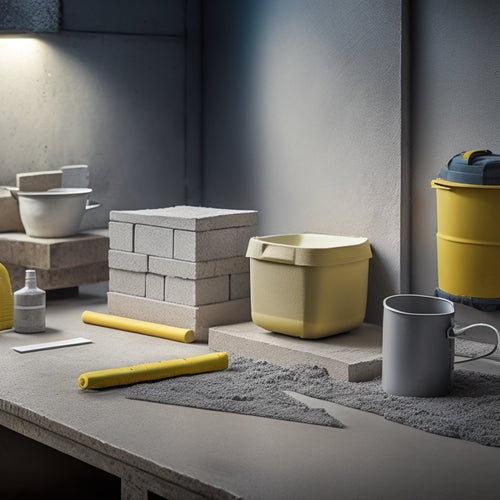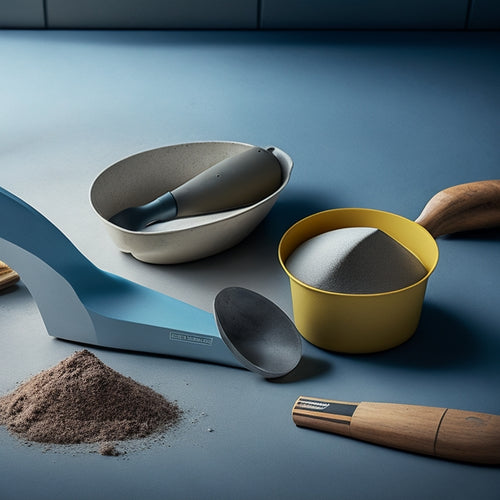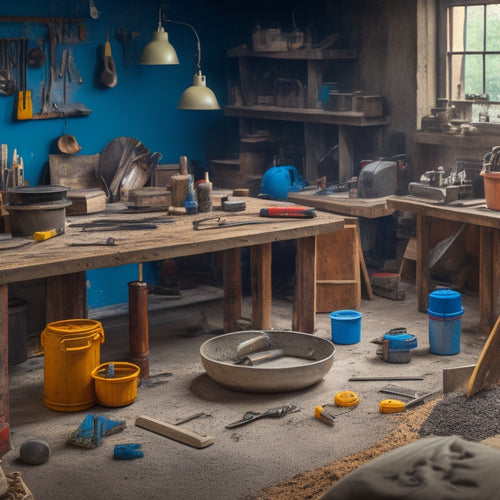
Top Tools for Laying Concrete Block Walls
Share
When laying concrete block walls, you'll need a range of specialized tools to guarantee accuracy, precision, and safety. Start with essential hand tools like spirit levels, tape measures, and trowels to maintain alignment and apply mortar. Heavy-duty machinery like concrete mixers, scaffolding systems, and block cutters will help you work efficiently and reduce labor. Don't forget measuring and leveling equipment, such as laser levels and plumb bobs, to guarantee accurate block placement. With the right tools and accessories, you'll be able to build walls that meet code and stand the test of time - and that's just the foundation of what you need to know to get the job done right.
Key Takeaways
• Essential hand tools, like spirit levels and trowels, ensure accurate block placement and strong bonds.
• Heavy-duty machinery, such as concrete mixers and block cutters, streamline the laying process and reduce manual labor.
• Measuring and leveling equipment, including laser levels and plumb bobs, guarantee precise block alignment and installation.
• Mixing and laying accessories, like high-quality mixers and jointers, facilitate efficient mortar application and finishing.
• Safety gear, including hard hats and dust masks, protect block layers from hazards and ensure a secure working environment.
Essential Hand Tools for Laying
When laying concrete block walls, you'll need a set of essential hand tools to secure accurate and efficient work, including a spirit level, tape measure, and torpedo level.
These tools will help you verify the blocks are properly aligned, spaced, and leveled. A spirit level, in particular, is vital for checking the vertical and horizontal alignment of the blocks. A tape measure will help you maintain consistent block spacing, which is important for the structural integrity of the wall.
You'll also need a trowel to apply the perfect amount of mortar to each block, using techniques such as the 'buttering' method to create a strong bond. Additionally, a jointer or pointing trowel will come in handy for finishing the joints between blocks.
Heavy-Duty Machinery for Block Walls
You'll need to bring in heavy-duty machinery, such as a mixer and a scaffolding system, to efficiently lay large quantities of concrete blocks and guarantee safe working conditions at heights. This equipment is essential for constructing block walls, especially for large-scale projects or commercial buildings. By investing in the right block wall equipment, you'll be able to complete your project quickly and accurately, while also ensuring the safety of your team.
Some of the key heavy-duty machinery you'll need includes:
-
Concrete mixers: These machines can handle large batches of concrete, saving you time and labor. Look for mixers with high-capacity drums and robust mixing mechanisms.
-
Scaffolding systems: These provide a stable and secure platform for your team to work from, allowing you to reach high areas safely.
-
Block cutters: These machines make quick work of cutting concrete blocks to size, saving you time and effort.
Measuring and Leveling Equipment
With your heavy-duty machinery in place, it's time to focus on the precision tools that'll confirm your concrete block walls are accurately measured and leveled.
You'll need measuring and leveling equipment to confirm your walls are straight, plumb, and level. A laser level is a must-have tool for this task. It projects a precise, self-leveling line or dot that indicates the desired level or grade. This allows you to accurately measure and mark the location of your blocks, confirming a perfectly aligned wall.
In addition to a laser level, you'll also need a chalk line reel to snap a line that serves as a guide for your block placement. This tool is especially useful when you're working with long walls or complex layouts.
By using a chalk line reel, you can quickly and easily mark the location of your blocks, saving you time and reducing the risk of errors.
With these precision tools in your arsenal, you'll be able to build concrete block walls that are strong, durable, and visually appealing.
Mixing and Laying Accessories
To guarantee a strong and durable bond between the concrete blocks, you're going to need the right mixing and laying accessories, including a mixer, trowels, and jointers that'll help you achieve the perfect mortar consistency and joint alignment.
When it comes to mixing, you'll want to master various mixing techniques to guarantee the ideal mortar type for your project. A mixer will come in handy for this task, allowing you to achieve the perfect consistency.
For laying, you'll need a range of trowels, including pointing trowels, finishing trowels, and joint trowels, to apply and shape the mortar.
Here are some essential mixing and laying accessories to add to your toolkit:
-
A high-quality mixer that can handle large batches of mortar
-
A set of trowels with varying blade angles and sizes for different applications
-
Jointers for creating clean, smooth joints between blocks
Safety Gear for Block Layers
Concrete block laying requires a range of safety gear to protect you from the physical demands and hazardous materials involved in the process. As a block layer, you're constantly exposed to heavy lifting, rough textures, and harsh chemicals, making personal protective equipment (PPE) a must-have.
Start with a durable hard hat to shield your head from falling objects and debris. Safety glasses or goggles will protect your eyes from dust, cement, and other particles. You'll also need heavy-duty gloves to grip blocks securely while protecting your hands from abrasions and cuts.
A dust mask or respirator is essential for preventing inhalation of silica dust and other airborne contaminants. Steel-toed boots with slip-resistant soles will keep your feet safe from heavy blocks and uneven surfaces.
Don't forget to wear long-sleeved shirts, pants, and a dust-resistant jacket to prevent skin irritation and contamination. By wearing the right safety gear, you'll greatly reduce the risk of injuries and illnesses, ensuring a safer and healthier workplace.
Frequently Asked Questions
How Do I Prevent Concrete Blocks From Absorbing Too Much Water?
When laying concrete blocks, you'll want to prevent water absorption to guarantee a strong, durable structure.
To do this, you'll need to employ effective waterproofing techniques and moisture management strategies.
Start by applying a waterproofing agent to the blocks before laying them, and make sure the surface is clean and dry.
Additionally, use a drainage system behind the wall to redirect water away from the blocks, reducing the risk of water absorption and structural damage.
What Is the Ideal Temperature for Laying Concrete Block Walls?
Fantastic foundation work begins with fine-tuned foresight!
When preparing for laying concrete block walls, you're wise to wonder about the perfect temperature.
Ideal laying conditions typically fall between 40°F and 90°F (4°C and 32°C), with a perfect range of 50°F to 70°F (10°C to 21°C).
Avoid extreme temperatures, as they can affect mortar hydration, strength, and overall wall integrity.
Can I Use a Laser Level for Indoor Block Wall Construction?
When you're constructing an indoor block wall, you're wondering if a laser level is a valuable addition to your toolkit. The answer is yes!
A laser level provides precise, accurate measurements, ensuring your walls are plumb and level. Its benefits shine in indoor construction, where space is limited and accuracy is key.
By using a laser level, you'll achieve professional-looking results and avoid costly mistakes.
Follow indoor construction tips, like setting up the laser on a stable tripod, to get the most out of this essential tool.
How Often Should I Clean My Concrete Block Laying Tools?
When it comes to tool maintenance, you should clean your concrete block laying tools regularly to guarantee accuracy and extend their lifespan.
Aim to clean them daily, or at least every 2-3 uses, to prevent mortar buildup and rust.
Use a wire brush to remove excess mortar, and lubricate moving parts to keep them running smoothly.
Are There Specific Concrete Block Laying Techniques for Curved Walls?
When building curved walls, you'll need to master specific techniques to accomplish a smooth, consistent curve.
Start by planning your block alignment carefully, using a string line or template to guide your lay.
For tighter curves, use a radial layout, and for wider ones, a segmented approach.
Guarantee each block is aligned to the curve, using shims or wedges to adjust as needed.
Conclusion
As you wrap up your concrete block wall project, remember that 'well begun is half done.'
Having the right tools for the job is vital to achieving professional results. From essential hand tools to heavy-duty machinery, measuring and leveling equipment, mixing and laying accessories, and safety gear, it's clear that a solid foundation is key to a successful build.
By investing in these top tools, you'll be well on your way to creating a sturdy, long-lasting concrete block wall that will stand the test of time.
Related Posts
-

What Tools Do I Need for Concrete Block Laying
You'll need a thorough set of tools to guarantee accurate, efficient, and professional concrete block laying. Essenti...
-

Ergonomic Concrete Tools for Tight Spaces
When you're tackling concrete work in tight spaces, ergonomic tools are your best bet for comfort and efficiency. The...
-

Budget-Friendly Tools for DIY Decorative Concrete Profiling
You can achieve professional-grade decorative concrete results on a budget by investing in the right combination of e...


